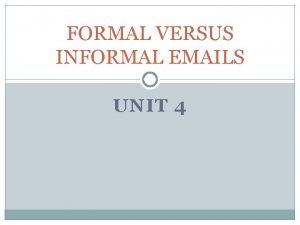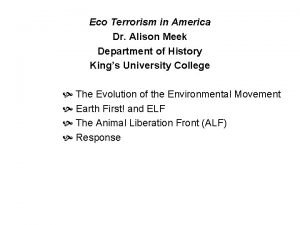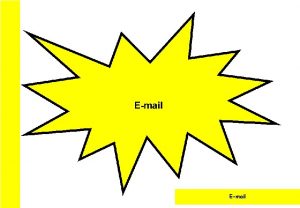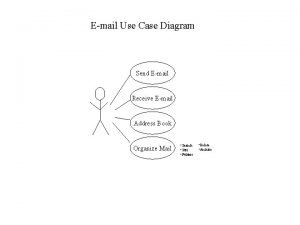General information Name developer Email developer Alison Allen


![Introduction exercises – design [please add graphics similar to the examples shown below] Photos: Introduction exercises – design [please add graphics similar to the examples shown below] Photos:](https://slidetodoc.com/presentation_image_h/ecffe267dde484db10deac2b50fdf0f2/image-3.jpg)




















- Slides: 23


General information Name developer: E-mail developer: Alison Allen Lesson number: S 4201 Grade: 4 Average target group: 9 Subject: What is a habitat? Location where the exercise takes place: Caribbean Sea - Mexico Theme: Mexican Diner alisonallen. design@gmail. com Before you start developing your storyboard, make sure you look at the learning goals for this lesson in the teacher guide slide (slide 17)
![Introduction exercises design please add graphics similar to the examples shown below Photos Introduction exercises – design [please add graphics similar to the examples shown below] Photos:](https://slidetodoc.com/presentation_image_h/ecffe267dde484db10deac2b50fdf0f2/image-3.jpg)
Introduction exercises – design [please add graphics similar to the examples shown below] Photos: Exterior of a traditional Mexican diner, with a Mexican/Latina 13 -14 year old girl with a camera (should look friendly, and have a camera, similar to example) and a Mexican/Latino 13 -14 year old boy (should look friendly). They should be sitting at a table in an outdoor seating area with a scrapbook on the table. Leave room for pop-up and photo example (see above and next page)

Introduction exercises - text Main Character of this lesson • Sofia (narrator): Mexican/Latina 13 -14 year old girl with a camera, friendly looking, casually dressed in outdoortype clothing (pants, jacket), with a camera around her neck or in her hand • Luis: a Mexican/Latino 13 -14 year old boy, friendly looking and casually dressed Text Main Character Sofia: Hola! My name is Sofia. I’m at my favorite Mexican diner to have lunch with my friend Luis. I just returned from a trip around the world with my family! I love to take pictures with my camera, so I have many photos of animals and plants that I saw in different habitats. I’m working on putting them into my scrapbook. Did you know that a habitat is a place where an organism lives? A suitable habitat must provide 5 things: Food, water, shelter, space, and air. Organisms thrive when they are in a habitat that is best suited to their needs. I was lucky to be able to explore five different habitats on my trip: a desert, a rainforest, the Arctic, mountains, and an ocean. I have so many photos and notes that I haven’t had time to finish my scrapbook about habitats around the world. Will you help me work on it? Text Tim You’ll be able to learn more about habitats by helping Sofia complete all the exercises in this lesson. You can click on me any time for more help!

Exercise 1 – design Background – Mexican diner w/Sofia and Luis, scrapbook page, one “Polaroid style” photo of a habitat for each activity, 3 label choices with legible font that looks like handwriting Drag the correct label to the habitat photo. desert mountains Arctic Use a different photo for each activity (see examples just above this text): Activity 1: Arctic, Activity 2: rainforest, Activity 3: mountains, Activity 4: ocean, Activity 5: desert

Drag & drop: Exercise #1 Type of exercise: Drag & drop Exercise: number & title: Exercise 1: Identifying habitats Question/problem main character: Sofia: I have so many photos that I haven’t had time to finish labeling all of them. Can you help me by labeling the habitat shown in each photo? Activity 1: (Arctic photo) Drag the correct label to the habitat photo. Arctic label should be dragged to bottom of photo of Arctic Label options: Desert, Mountains, Arctic Activity 2: (rainforest photo) Drag the correct label to the habitat photo. rainforest label should be dragged to bottom of photo of rainforest Label options: Arctic, Rainforest, Ocean Activity 3: (mountains photo) Drag the correct label to the habitat photo. mountains label should be dragged to bottom of photo of mountains Label options: Mountains, Desert, Rainforest Activity 4: (ocean photo) Drag the correct label to the habitat photo. ocean label should be dragged to bottom of photo of ocean Label options: Rainforest, Mountains, Ocean Activity 5: (desert photo) Drag the correct label to the habitat photo. desert label should be dragged to bottom of photo of desert Label options: Mountains, Desert, Arctic Thank you by main character: You did a great job labeling these habitat photos. Thanks for the help!

Explanation exercise 1 – Help provided by Tim Generic text Look closely at the photo to identify the habitat. Drag the label with the habitat name to the bottom of the photo. Image example 1 Screenshot of Activity 1: The “Arctic” label should be on the bottom of the “Arctic” photo Explanation 1 This photo shows a habitat with cold temperatures, ice, and snow. This is a photo of an Arctic habitat. Image example 2 Screenshot of Activity 5: The “desert” label should be on the bottom of the “desert” photo Explanation 2 This photo shows a habitat with hot temperatures, little water, and few plants. This is a photo of a desert habitat.

Exercise 2 – design background – Mexican diner w/Sofia and Luis, scrapbook page, one “Polaroid style” photo of an animal, notes section with legible font that looks like handwriting (same as Exercise 1), 4 multiple choices should look like “Post-it” notes Notes Eats mostly insects Lives near ponds, streams, and rivers Has suction cups on its toes so it can climb trees red-eyed tree frog Which habitat is best for the red-eyed tree frog? rainforest desert ocean Arctic Need 5 photos total – one for each activity as described below and on next slide, see examples above

Multiple Choice (exercise 2) Type of exercise: Multiple Choice Exercise number & title: Exercise 2: Animals and their Habitats Question/problem main character Sofia: I have a lot of scrapbook pages with photos and notes of animals I saw on my trip. I need to organize them by habitat. Can you help by selecting the correct habitat for each animal? Activity 1: Red-eyed tree frog photo Notes: • Eats mostly insects • Lives near ponds, streams, and rivers • Has suction cups on its toes so it can climb trees Which habitat is best for the red-eyed tree frog? rainforest desert ocean Arctic Activity 2: sidewinder rattlesnake photo Notes: • Eats small rodents • Lives buried in the sand or in animal burrows • Pale to brown in color to so it can blend in with the sand Which habitat is best for the sidewinder rattlesnake? desert mountains rainforest ocean Activity 3: walrus photo Notes: • Eats clams, snails, and crabs • Lives in shallow water by ice floes or land • Has blubber under their skin to protect them from cold water Which habitat is best for the walrus? Arctic rainforest mountains desert Activity 4: bottlenose dolphin photo Notes: • Hunt in groups to eat schools of fish • Found mostly in temperate and tropical waters • Mammals, but blowholes in their heads allow them to breathe Which habitat is best for the bottlenose dolphin? ocean desert rainforest mountains Activity 5: goat photo Notes: • Grazes vegetation found on ledges and cliff faces • Can survive at high altitudes (heights) • Moves well on steep, rocky surfaces Which habitat is best for the goat? mountains ocean desert rainforest Thank you by main character Good work! You selected the correct habitat for all the animals. Thanks for helping me get organized!

Explanation exercise 2 – Help provided by Tim Generic text Look at the photo and read Sofia’s notes to help you identify the best habitat for the animal. Click on the note with the name of the best habitat for the animal. Image example 1 Screenshot of activity 2: The “sidewinder rattlesnake” note should be selected for the activity with the “sidewinder rattlesnake” photo and notes Explanation 1 These notes describe an animal that has adapted in order to survive in sand. The best habitat for the sidewinder rattlesnake is the desert. Image example 2 Screenshot of activity 4: The “bottlenose dolphin” note should be selected for the activity with the “bottlenose dolphin” photo and notes Explanation 2 These notes describe an animal that has adapted in order to survive in water. The best habitat for the bottlenose dolphin is the ocean.

Exercise 3 – design Background – Mexican diner w/Sofia and Luis. Activity overlay is scrapbook page, one “Polaroid style” photo of a habitat for each activity, label with legible font that looks like handwriting (same as Exercise 1), True/False question mesquite tree: Stores water in deep roots to survive hot and dry conditions The mesquite tree grows well in deserts. True False Use a different photo for each activity (see examples just above this text): Activity 1: mesquite tree, Activity 2: big-leaf mahogany tree, Activity 3: cork oak tree, Activity 4: kelp, Activity 5: bearberry

True / False Template Type of exercise: True/False Exercise number & title: Plants and their Habitats Question/problem main character: Sofia: I know a lot about animals and their habitats, but I have a test at school next week on plant habitats. Will you help me study by figuring out if these statements about plants are true or false? Activity 1: Photo of mesquite tree: Stores water in deep roots to survive hot and dry conditions The mesquite tree grows well in deserts. True Activity 2: Photo of big-leaf mahogany tree: Has wide branches to absorb as much sunlight as possible to produce food The big-leaf mahogany tree does not grow well in rainforests. False Activity 3: photo of cork oak tree: Can grow at high altitudes, and its thick bark can be harvested as cork without harming the tree The cork oak tree provides a livelihood for people who live in the mountains. True Activity 4: photo of kelp: An algae that provides shelter and food for many types of sea creatures Kelp provides a good habitat for other ocean organisms. True Activity 5: photo of bearberry plant bearberry: Its fine silky hairs and leathery leaves help keep it warm. A bearberry plant would not survive in the Arctic. False Thank you by main character Thanks for helping me study plant habitats. Great job!

Explanation exercise 3 – Help provided by Tim Generic text Look at the photo and read the fact about the plant to help you determine if each statement is true or false. Click on true or false to complete the activity. Image example 1 Screenshot of activity 1: “True” should be selected for the activity “The mesquite tree grows well in deserts. ” Explanation 1 The plant fact states that the mesquite tree can survive hot, dry conditions. A desert habitat is hot and dry, so the statement is true. Image example 2 Screenshot of activity 5: “False” should be selected for the activity “A bearberry plant would not survive in the Arctic. ” Explanation 2 The plant fact states that the bearberry plant’s hairs and leaves help keep it warm. An Arctic habitat is cold, so the statement is false.

Exercise 4 – design background – Mexican diner w/Sofia and Luis. scrapbook page, “Polaroid style” photo of a box with about 10 earthworms in the middle, 4 types of soil in each corner – see photo examples below, labels with legible font that looks like handwriting (same as Exercise 1) Earthworm Science Project Results: sand dead leaves worms Habitat (Soil Type) Number of Earthworms in the Soil Sand 0 Gravel 3 Dead leaves 6 Potting soil 1 gravel potting soil Which habitat (soil type) did the earthworms prefer most? sand gravel potting soil dead leaves Need 5 photos total – see examples above – worms, dead leaves, sand, potting soil, gravel. And chart.

Multiple Choice (exercise 4) Type of exercise: Multiple Choice Exercise number & title: Exercise 4: Science Project: Earthworm Habitats Question/problem main character Sofia: We placed 10 earthworms in the middle of the box with different types of soil and closed it. After 24 hours, we recorded how many earthworms were in each type of soil. I haven’t had time to look at the results yet. Can you help me answer a few questions about the results of the experiment? Activity 1: Which habitat (soil type) did the earthworms prefer most? dead leaves sand potting soil gravel Activity 2: Which habitat (soil type) did the earthworms prefer least? sand gravel dead leaves potting soil Activity 3: What is the most likely reason the earthworms preferred dead leaves? They could eat the dead leaves to survive. They liked the color of the dead leaves. The dead leaves smelled good. They could not eat the dead leaves to survive. Activity 4: Which habitats probably had the least amount of food (organic matter) for the earthworms? sand potting soil sand gravel potting soil and dead leaves gravel and dead leaves Thank you by main character Thanks for helping me answer these questions about my science project. Good job!

Explanation exercise 4 – Help provided by Tim Generic text Read the information about the science project. Then use the results chart to help you answer the question. Image example 1 Activity 1: The answer “dead leaves” should be selected for the question: “Which habitat (soil type) did the earthworms prefer most? ” Explanation 1 The results chart shows 6 earthworms were in the dead leaves. The habitat preferred by the most earthworms was dead leaves. Image example 2 Activity 2: The answer “sand” should be selected for the question: “Which habitat (soil type) did the earthworms prefer least? ” Explanation 2 The results chart shows 0 earthworms were in the sand. The habitat preferred by the least earthworms was sand.

1. Teacher guide Overall Learning Goals At the end of this lesson, the student should: • understand what a habitat is and how it relates to organisms • know some types of habitats Learning Goal: Exercise 1 Know some types of habitats (identifying habitats) Learning Goal: Exercise 2 Understand what a habitat is and how it relates to organisms (animals) Learning Goal: Exercise 3 Understand what a habitat is and how it relates to organisms (plants) Learning Goal: Exercise 4 Understand how a habitat relates to organisms (earthworms)

Templates • Type of exercises (1 – 5)

Multiple Choice Template Type of exercise: Multiple Choice Exercise number & title: [which exercise is this? What is the title of the exercise? ] Question/problem main character [add text of main character formulated as the problem he/she needs help with solving] Activity 1: [Question/assignment] [right answer] [wrong answer] Activity 2: [Question/assignment] [right answer] [wrong answer] Activity 3: [Question/assignment] [right answer] [wrong answer] Activity 4: [Question/assignment] [right answer] [wrong answer] Activity 5: [Question/assignment] [right answer] [wrong answer] Thank you by main character [provide text for main character to thank the user for his/her help]

True / False Template Type of exercise: True/False Exercise number & title: [which exercise is this? What is the title of the exercise? ] Question/problem main character: [add text of main character formulated as the problem he/she needs help with solving] Activity 1: [text of answer] [is the right answer true or false? ] Activity 2: [text of answer] [is the right answer true or false? ] Activity 3: [text of answer] [is the right answer true or false? ] Activity 4: [text of answer] [is the right answer true or false? ] Activity 5: [text of answer] [is the right answer true or false? ] Thank you by main character [provide text for main character to thank the user for his/her help]

Drag & drop Template Type of exercise: Drag & drop Exercise: number & title: [which exercise is this? What is the title of the exercise? ] Question/problem main character: [add text of main character formulated as the problem he/she needs help with solving] Activity 1: [Question/assignment] [which object(s) need to be dragged & dropped where? ] Activity 2: [Question/assignment] [which object(s) need to be dragged & dropped where? ] Activity 3: [Question/assignment] [which object(s) need to be dragged & dropped where? ] Activity 4: [Question/assignment] [which object(s) need to be dragged & dropped where? ] Activity 5: [Question/assignment] [which object(s) need to be dragged & dropped where? ] Thank you by main character: [provide text for main character to thank the user for his/her help]

Tick the box Template Type of exercise: Tick the box Exercise number & title: [which exercise is this? What is the title of the exercise? ] Question/ problem main character: [add text of main character formulated as the problem he/she needs help with solving] Activity 1: [Question/assignment] [possible answers] [right answers] Activity 2: [Question/assignment] [possible answers] [right answers] Activity 3: [Question/assignment] [possible answers] [right answers] Activity 4: [Question/assignment] [possible answers] [right answers] Activity 5: [Question/assignment] [possible answers] [right answers] Thank you main character: [provide text for main character to thank the user for his/her help]

Matching Template Type of exercise: Matching Exercise: number & title: [which exercise is this? What is the title of the exercise? ] Question/problem main character: [add text of main character formulated as the problem he/she needs help with solving] Activity 1: [Question/assignment] [describe objects/items that should be [with what should the objects/items matched] be matched? ] Activity 2: [Question/assignment] [describe objects/items that should be [with what should the objects/items matched] be matched? ] Activity 3: [Question/assignment] [describe objects/items that should be [with what should the objects/items matched] be matched? ] Activity 4: [Question/assignment] [describe objects/items that should be [with what should the objects/items matched] be matched? ] Activity 5: [Question/assignment] [describe objects/items that should be [with what should the objects/items matched] be matched? ] Thank you by main character: [provide text for main character to thank the user for his/her help]
 Wanderers nachtlied 2 analyse
Wanderers nachtlied 2 analyse Name 3 points
Name 3 points Format of informal email
Format of informal email How to write an email requesting information
How to write an email requesting information Letter of enquiry about a trip
Letter of enquiry about a trip Cay ryan murray nude
Cay ryan murray nude Alison voice leeds
Alison voice leeds Alison bromley psychologist
Alison bromley psychologist What is the area
What is the area Real life superheroes book by alison
Real life superheroes book by alison Alison crane
Alison crane Dr alison giles
Dr alison giles Alison lockley
Alison lockley Dr alison tucker
Dr alison tucker Alison bourke
Alison bourke Alison tyson xxx
Alison tyson xxx Alison meek
Alison meek Alison lin nci
Alison lin nci Pest control alison
Pest control alison Alison kuykendall
Alison kuykendall Dr alison landrey
Dr alison landrey Nina champaneri
Nina champaneri Alison ernst
Alison ernst Alison kirkwood
Alison kirkwood













































